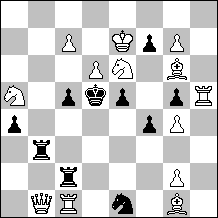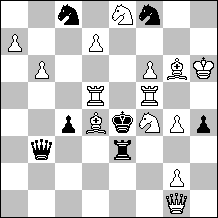|
There are few countries that can field as strong a team of expert twomove composers as those competing in this match, and I therefore
looked forward with enthusiasm to the judging process. When I first saw
the chosen theme, I must admit I doubted whether it offered enough scope
for interest and originality. I need not have worried. The best of the
24 problems submitted (there were 12 from each country altogether) are
splendid works, with plenty of really novel and ingenious ideas. I
consulted Udo Degener, to whom I send my thanks, regarding possible
anticipations, but he could find no obvious forerunners, and gave it as
his view that the theme had not been much worked. He did offer a few
published problems for comparison, but fortunately there was nothing
among them that could be counted as a clear anticipation. However, I had
to exclude A7 from consideration, as it was much too similar to the
Lukyanov problem quoted in the match announcement. At a very late stage,
A19, which would have occupied 11th place, was found to be totally
anticipated (V. Pilchenko & V. Shavyrin,
Zadachi i Etyudy 2000)
and had to be removed from the award.
There can be no doubt that the theme is not easy to set intensively.
Among the competing problems there were a few that aimed at a task
rendering, but these, in my view, were not among the top entries, and
most of them displayed constructional weaknesses that ruled them out of
contention. In fact, the difficulty of the theme is shown by the fact
that almost all the entries, even the best of them, show some feature of
construction that is not ideal. In my remarks I comment on these
features, many of them quite unavoidable.
What caused me the most difficulty was the usual theme-tourney
dilemma: how to compare intensive renderings of the theme, perhaps
containing several phases or multiple mates on one square, with arguably
better problems showing the theme in more restrained fashion. In the end
the judge has to rely on his sense of chess problem aesthetics, which
may sometimes tell against the intensive rendering. Fortunately, on this
occasion most of the best entries were both fairly intensive and
artistically satisfying, a real tribute to the skill and ingenuity of
the composers involved. I thank them for providing such a fine range of
high-quality problems, and I am very grateful for having been given the
opportunity to study them in depth. It is worth mentioning as well that
I found a few quite presentable problems among those that had to be
excluded because of the high quality of the best 12 entries.
|













